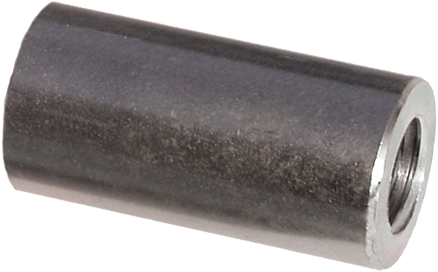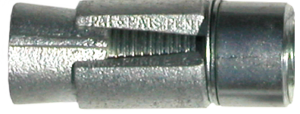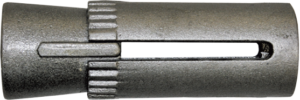R1H Hollow-Core Spin-Lock Rock Bolt
Prestressable • Positive Grouting • Permanent
Through years of development Williams has produced and patented the prestressable, groutable, Hollow-Core Spin-Lock Rock Bolting Systems. The hollow-core allows the bolt to always be grouted from the lowest gravitational point. In an up-bolting situation, the grout is pumped in through the plastic grout tube and begins to fill the drill hole from the plate. The grout rises until the entire hole is filled and the grout returns through the hollow bar. In down grouting situations, the grout is pumped through the hollow bar and starts at the bottom of the hole. Grout rises and returns through the de-air tube when the hole is filled. Improperly or incomplete grouted bolts are subjected to relaxation and corrosion. Pre-measured capsule systems cannot properly account for unknown fissures and voids and often leave the bolt vulnerable to deterioration. The Williams Hollow-Core Grouting System spreads grout through the rock fissures creating a completely protected monolithic section including rock, grout and bolt. Because the Spin-Lock head assembly provides 300º perimeter expansion anchorage and develops the full strength of the rod, the hollow-core rock bolt may be prestressed to the desired load and tested prior to grouting. The 1” diameter Hollow-Core is also available in an All-Thread design of identical capacities. Unfortunately, the Hollow-Core rebar is not available from a domestic source.
R1H Structural Properties
| Yield Stress |
Ultimate Stress |
Elongation in 2” (51 mm) |
Reduction of Area |
|---|---|---|---|
| 91 KSI (627 MPa) |
124 KSI (854 MPa) |
15% min | 40% min |
R1H High Grade Hollow-Core Rock Anchor
ASTM A615 Deformation Pattern
| Dia & Threads per In |
Max Recommended Design Load at 2:1 Safety Factor |
Yield Strength (fy) |
Ultimate Strength (fu) |
Drill Hole Diameter (1) |
Type Head Ass’y |
Torque (ft-lbs) | Part Number |
|
|---|---|---|---|---|---|---|---|---|
| To Expand Shell (2) |
On Nut for Tension (3) |
|||||||
| 1” – 8 (25 mm) |
33 kips (147 kN) |
47 kips (209 kN) |
66 kips (294 kN) |
1-5/8” – 41 mm) 1-3/4” – (44 mm) 1-3/4” – (44 mm) 2” – (51 mm) |
A 13 B 14 C 14 B 16 |
250 ft-lbs (450*) |
400 | R1H08A13 R1H08B14 R1H08C14 R1H08B16 |
| 1-3/8” – 8 (35 mm) |
69 kips (307 kN) |
100 kips (445 kN) |
138 kips (614 kN) |
2-1/2” – (64 mm) 3” – (76 mm) |
B 20 B 24 |
750 ft-lbs (1200*) |
Note (4) | R1H11B20 R1H11B24 |
| 2” – 6 (51 mm) |
150 kips (667 kN) |
219 kips (974 kN) |
300 kips (1334 kN) |
3-1/2” – (89 mm) | C 28 | 1000 ft-lbs (3700*) |
Note (4) | R1H16C28 |
(*) Do not exceed these numbers
(1) Care should be taken to drill a straight and properly sized hole.
(2) A function of strata strength. More torque may be required on long anchors or in special rock conditions. Consult your Williams Representative.
(3) Torque value listed will achieve approximate load of 50% of the anchor ultimate strength, and is based on the torque tension curves here.
(4) Stress to desired tensile load using a hollow ram hydraulic jack. Consult your Williams Representative. – Inconsistencies in rock from site to site and even from hole to hole may affect anchor performances. Fissures, voids, seams, rock psi, drilling through clay or bentonite and direction of bedding planes are all possible variables. Should problems occur, consult Williams for troubleshooting.
– Spin-Locks come standard with 12” of threaded area. Other lengths available upon request.
– WILLIAMS reserves the right to ship full length or coupled units as necessary.
Head Assemblies
The Williams Spin-Lock anchor assembly gives full 300° bearing area. The smooth shell design allows for maximum shell to rock contact and eliminates “point of contact” created by serrated designs. The cone design supports the shell 300°, thereby eliminating any possible collapse of the shell under high load conditions. The thrust ring stop in front of the shell prevents any possible rebound of the expanded shell down the cone when subjected to nearby blasting. The Williams Spin-Lock anchor has been field proven on the world’s largest projects to far exceed in tension capacity any other mechanical anchor on the market.
| Head Assembly |
Drill Hole Diameter |
Bolt Diameter & Pitch |
Cone | Shell | Thrust Ring | Slip Rings |
Overall Assembly Length |
|||
|---|---|---|---|---|---|---|---|---|---|---|
| Length | Part No. | Length | Part No. | Diameter | Thickness | |||||
| A13 | 1-5/8” (41 mm) |
1” – 8 NC (25 mm) |
1-7/8” (48 mm) |
SC-158-8 | 1-7/8” (48 mm) |
SS-158 | 1-1/2″ (38 mm) |
9/16″ (14 mm) |
1/16″ (1.6 mm) |
4-1/8” (108 mm) |
| B14 | 1-3/4” (44 mm) |
1” – 8 NC (25 mm) |
3-3/4” (95 mm) |
LC-158-8 | 3-3/4” | LS-175 | 1-5/8” (41mm) |
15/16″ (24 mm) |
1/16″ (1.6 mm) |
8-1/2” (216 mm) |
| B16 | 2” (51 mm) |
1” – 8 NC (25 mm) |
2-1/2” (64 mm) |
LC-200-8 | 4” (102 mm) |
LS-200 | 1-7/8” (48 mm) |
15/16″ (24 mm) |
1/16″ (1.6 mm) |
7-3/8” (187 mm) |
| B20 | 2-1/2” (64 mm) |
1-3/8” – 8 UN (35 mm) |
4” (102 mm) |
LC-250 | 4” (102 mm) |
LS-250 | 2-1/8” (54 mm) |
1-3/8″ ( 35mm) |
9/64″ (3.6 mm) |
9-5/8” (244 mm) |
| B24 | 3” (76 mm) |
1-3/8” – 8 UN (35 mm) |
5-1/2” (140 mm) |
LC-300 | 5-1/2” (140 mm) |
LS-300 | 2-3/4” (70 mm) |
1-3/8″ ( 35mm) |
1/8″ (3 mm) |
12-1/2” (318 mm) |
| C14 | 1-3/4” (44 mm) |
1” – 8 NC (25 mm) |
4-1/4” (108 mm) |
LCF-175-8 | 3-3/4” (95 mm) |
LS-175 | 1-5/8″ (41 mm) |
1-1/4″ (32 mm) |
1/16″ (1.6 mm) |
9-3/16” (233 mm) |
| C28 | 3-1/2” (89 mm) |
2” – 6 UN (51 mm) |
7” (178 mm) |
LCF-350-16 | 6” (152 mm) |
LS-350 | 2-7/8” (73 mm) |
2” (51 mm) |
1/8″ (3.2 mm) |
15-1/8” (384 mm) |
Coupled Head Assemblies

Williams can manufacture Spin-Lock Anchor systems with the use of a transition coupling, which allows the anchor to be designed with a continuously workable thread-form. This is advantageous when the anchor length may need to be adjusted in the field due to variable site conditions. The transition coupling engages a continuously threaded U.N. bar into the head assembly and the All-Thread Bar (typically Grade 75 & Grade 80 All-Thread Rebar or 150 KSI All-Thread-Bar) is attached to the other end of the coupling.
C2T Stop-Type Couplings & C2D Flange Couplings

| Bar Diameter |
Outside Diameter |
Overall Length |
Stop-Type Part Number |
Flange Coupling | |
|---|---|---|---|---|---|
| Flange Size | Part Number | ||||
| 1” (25 mm) |
1-1/2” (38 mm) |
3” (76 mm) |
C2T-08 | 3” x 3” (76 x 76 mm) |
C2D-08 |
| 1-3/8” (35 mm) |
2-1/8” (54 mm) |
4” (102 mm) |
C2T-11 | 3” x 3” (76 x 76 mm) |
C2D-11 |
| 2” (51 mm) |
3” (76 mm) |
6” (152 mm) |
C2T-16 | – | – |
H1F Heavy Duty Hex Nuts

| Bar Diameter |
Across Flats |
Across Corners |
Thickness | Part Number |
|---|---|---|---|---|
| 1” (25 mm) |
1-5/8” (41 mm) |
1.9” (48 mm) |
63/64” (25 mm) |
H1F-08 |
| 1-3/8” (36 mm) |
2-3/16” (56 mm) |
2.5” (64 mm) |
1-11/32” (34 mm) |
H1F-11 |
| 2” (51 mm) |
3-1/8” (79 mm) |
3.6” (92 mm) |
1-31/32” (50 mm) |
H1F-16 |
R9F Hardened Washers

| Bar Diameter |
Outside Diameter |
Inside Diameter |
Thickness | Part Number |
|---|---|---|---|---|
| 1” (25 mm) |
2” (51 mm) |
1-1/16” (29 mm) |
5/32” (4 mm) |
R9F-08-436 |
| 1-3/8” (36 mm) |
2-3/4” (70 mm) |
1-1/2” (38 mm) |
5/32” (4 mm) |
R9F-11-436 |
| 2” (51 mm) |
3-3/4” (95 mm) |
2-1/8” (54 mm) |
7/32” (5.6 mm) |
R9F-16-436 |
R8M Beveled Washers

| Bar Diameter |
Degree of Bevel |
Outside Diameter |
Inside Diameter |
Maximum Thickness |
Minimum Thickness |
Part Number |
|---|---|---|---|---|---|---|
| 1” (25 mm) |
15° | 2-1/16” (52 mm) |
1” (25 mm) |
3/4” (19 mm) |
1/4” (6 mm) |
R8M-08S |
| 1-3/8” (36 mm) |
15° | 3-3/8” (86 mm) |
1-9/16” (40 mm) |
1-15/64” (31 mm) |
3/8” (9.5 mm) |
R8M-12S |
| 2” (51 mm) |
5° | 3-9/16” (91 mm) |
2-1/16” (52 mm) |
13/16” (21 mm) |
1/2” (13 mm) |
R8M-16 |
To achieve full strength of the nut, beveled washers must be used in conjunction with a hardened washer.





